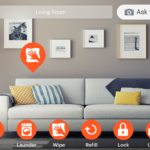[:en]Recently, we wrote an article on how to determine the going rate for vacation rental cleaning in your area. Our post calculated an hourly rate, as our knowledge of global trends indicates that’s more common, but a few of our readers sent us this question:
How do you calculate a flat rate?
Several wanted to know how to calculate a flat rate based on the number of bedrooms and bathrooms, and how much the flat rate should be adjusted for additional services such as laundry or restocking.
Does such an equation exist? Can you multiply x bedrooms by $20 and y bathrooms by $30? Would you need to change the parameters if the bedroom had more than z items of furniture or the bathroom had both a bidet and a toilet to sanitize?
While flat rates are common in some areas, the equation for calculating the flat rate usually comes directly from the number we’ve already established: the cost for an hour’s worth of cleaning in your area. Let’s look at how to create a flat rate from that information.
How Is the Flat Rate Established?
Let’s say you’re a vacation rental manager, and a cleaner tells you it will be a flat rate of $200 to clean a 4-bedroom, 2-bath property. Or let’s say you’re a cleaner, and a vacation rental manager offers you a flat rate of $80 to clean a 1-bedroom apartment while doing laundry turnover.
How did these two people calculate that flat rate? How did they decide that this cleaning was worth X amount of money?
Flat rates are generally determined by calculating how much time it should take to perform this particular clean, and multiplying that number of hours by the hourly rate.
If the cleaner knows that it typically takes about 4 hours to clean a house of that size, and $50/hour is standard in her area, then she thinks $200 is a fair flat rate.
Similarly, the vacation rental manager knows it takes about 2 hours to clean the 1-bedroom apartment while allowing time to finish folding the laundry when it’s done. She multiplies that 2 hours by her local hourly rate of $40 to arrive at a flat rate of $80.
If additional services were added to either job, the flat rate would go up, because it will take more time to clean the property. A flat rate is simply an hourly rate multiplied by the most likely number of hours the job will take.
So Why Use a Flat Rate at All?
A flat rate is protection for both the vacation rental manager and the cleaning service.
If the cleaner charges an hourly rate, and does an exceptionally efficient job of cleaning the property, she’ll get paid less for the job despite the quality of her work and the skill it takes to complete it so quickly.
On the other hand, if a cleaner accidentally forgets to transfer the linens from the washing machine to the dryer midway through the job, they’ll need to stay in the property an additional hour to wait for the dryer to finish drying the linens.
In this case, the flat rate protects the property manager from being charged extra if the job takes more time than it should.
Flat rates can be very popular for this reason. Cleaners who do their jobs efficiently and well will be able to get a higher hourly rate for their services. Vacation rental managers are assured that the cost of a clean for each property is constant, which helps them to budget and plan ahead.
Flat rates can be an excellent way of setting a price for a clean, but the flat rate always comes from an hourly rate multiplied by the number of hours the job is likely to take.
Without that calculation, a cleaner might accept a flat rate of $100 for a job that winds up taking five hours. That’s far too low a rate for the amount of time she invests in the job.
Which is why it’s essential, when setting a flat rate, to make a reasonable estimate of the number of hours a clean will take.
How Many Hours Will a Clean Take?
This question is, effectively, what most people are asking for when they think of setting a rate based on the number of bathrooms and bedrooms. More bedrooms and bathrooms means more time needed to perform a cleaning turnover for the whole property.
Bedrooms and bathrooms are only the beginning, however. Properties that have kitchens with lots of appliances like cappuccino makers will take more time to clean. Properties that have furniture with lots of little nooks and crannies will take more time. Properties where laundry turnover and restocking are required will take more time.
In other words? Calculating a fair price for a clean is far too complex an equation to be reduced to beds and baths.
If you already have experience with hospitality cleaning, you can probably make a reasonable guess on the hours it will take to clean a given property. If necessary, you can always adjust your quote for the next pass.
If you’re just getting started in this industry, however, you might have a difficult time guessing how long it will take to clean a property correctly.
Cleaners in this situation should start by getting a bit of experience with the amount of time it takes to clean a property to hospitality standards. There’s an easy place to start: your own home.
Start by getting the room tidied – the guests won’t be leaving behind piles of mail on the kitchen counter or a hamper full of dirty laundry in the bedroom. Once it’s more or less free of clutter, start a timer and clean to the standard expected from a vacation rental: every corner free of dust, every item picked up and wiped down, and the room staged to look attractive.
Do this for a bedroom, a bathroom, a family room, and a kitchen, and you’ll have a good notion of how long it will take you to clean each of those room types.
You’ll also have some information about what types of tasks take longer: furniture with carvings or details that need to be cleaned carefully, rooms with high ceilings or easily-stained carpeting, and surfaces holding a lot of items that need to picked up and cleaned individually.
With that information, you can probably make a very reasonable guess at how long it will take you to clean a given room when you’re shown pictures of a property.
Multiply by your hourly rate, and you’ll have a quote. Adjust up or down from there as you gain more experience.
For property managers, you have an easier way to get this information: ask. Call a handful of cleaning services and send them pictures of the property you’d like cleaned. Ask for an estimate. When they give you the estimate, ask about how many hours of cleaning that quote includes so that you can be sure to schedule enough time.
You now have a flat rate and a number of hours. Divide the flat rate by the number of hours, and you know approximately how much money this cleaner would like to be paid per hour.
After they give you a quote for the property itself, you can ask how much it would be to add on laundry service, restocking, or anything else you want to have a price for. They may have an a la carte rate for that service, or they may adjust their flat rate quote.
Either way, you now know what that additional service is worth to the cleaner, and therefore approximately how much time it will take.
You can repeat this process for a number of properties until you have a good idea of how to estimate the number of hours it would take to clean a given property.
Why Not Skip Straight to the Flat Rate?
You could use all of the flat rates you’ve collected and average them out for your own flat rate on, say, a 4-bedroom property. You might then think you could use that flat rate for every property of the same size.
The problem with averaging flat rates is the same as before: some properties are easier to clean than others.
Which means your flat rate for that 4-bedroom may be too much for another property that’s easier to clean, and too little for a 4-bedroom that’s more difficult.
If you know how long it takes to clean the property and what hourly rate cleaners in your area expect, however, your flat rate should always be accurate. Calculating based on how difficult the property is to clean, rather than on its size, will give you a better quote every time.
Want to test out your flat rate for a given clean? Try the Properly Community Marketplace. Cleaners in your area can review the property’s photos and will accept your quote if they think it’s fair. It’s just one of the many ways using Properly makes managing vacation rentals easier. Click here to learn a few more. [:]



